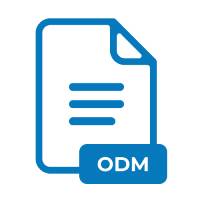.ODM File Extension

OpenDocument Master Document
| Developer | OASIS |
| Popularity | |
| Category | Text Files |
| Format | .ODM |
| Cross Platform | Update Soon |
What is an ODM file?
.ODM files, or OverDrive Media files, are closely associated with the digital distribution of e-books and audiobooks.
They are primarily used in the context of library loan systems and are a pivotal component of the digital media management services provided by OverDrive, Inc.
These files serve as gateways, rather than containers of media content, directing users to the actual media files through digital rights management (DRM) systems.
More Information.
OverDrive, founded in the 1980s, initially dealt with document conversion and digitization services. As the digital era progressed, OverDrive shifted its focus to digital content distribution, recognizing the need for a robust system to manage and distribute digital media, especially for libraries.
The .ODM file format was introduced as part of OverDrive’s broader ecosystem, designed to facilitate secure and efficient borrowing of digital media, mirroring the traditional library borrowing system but in a digital context.
The format was tailored to ensure that borrowed media could be accessed by authorized users for a specific period, after which access would be automatically revoked, mirroring the concept of returning a borrowed item.
Origin Of This File.
The .ODM file format was conceived and developed by OverDrive, Inc., a digital distributor of e-books, audiobooks, music, and video titles.
The company’s innovative approach to digital content distribution to libraries and schools necessitated the creation of a format that could manage digital rights and access to borrowed digital content effectively.
.ODM files emerged as a solution, integrating seamlessly with OverDrive’s media services and applications.
File Structure Technical Specification.
.ODM files are essentially XML files, structured and formatted to contain metadata and URLs pointing to the actual media content. The file includes detailed information about the media, such as title, author, and publisher, as well as the borrowing terms and DRM information.
When opened through compatible software, the .ODM file triggers the download and activation of the media content, ensuring that the content is accessed within the parameters set by the library or distributor, including the borrowing duration and digital rights.
How to Convert the File?
Converting .ODM (OverDrive Media) files into other formats is not a straightforward process due to the DRM (Digital Rights Management) protection embedded within them.
.ODM files are essentially license files issued by the OverDrive Media service, and they are meant to control the borrowing period and usage rights of digital media, such as audiobooks or eBooks.
These files don’t contain the media themselves but point to where and how the media can be downloaded. Here’s how you generally interact with these files:
- Use Authorized Applications: The content tied to .ODM files can only be accessed through authorized applications like the OverDrive app or Libby by OverDrive. These applications will handle the download, decryption, and playback or display of the media content.
- DRM Considerations: Attempting to convert .ODM files to other media formats might involve removing DRM protections, which is against the terms of service of most digital content providers and can be illegal.
Advantages And Disadvantages.
Advantages:
- Secure Distribution: .ODM files enable secure and controlled distribution of digital media, ensuring that copyright laws and borrowing terms are adhered to.
- Convenience: Users can borrow and access digital media from the comfort of their homes, using various devices.
- Integration with Library Systems: .ODM seamlessly integrates with existing library loan systems, providing users with a familiar borrowing experience.
Disadvantages:
- Dependency on Specific Software: To open and use .ODM files, users must have compatible software installed, such as the OverDrive app or Adobe Digital Editions.
- DRM Restrictions: The digital rights management embedded in .ODM files can be seen as restrictive, limiting the user’s ability to use the media on multiple devices or share it with others.
- Technical Issues: Users may encounter technical issues related to software compatibility, file corruption, or DRM malfunctions.
How to Open ODM?
Open In Windows
OverDrive for Windows or Adobe Digital Editions:
- Download and install the OverDrive desktop app or Adobe Digital Editions.
- Locate the .ODM file in your file system, right-click on it, and choose “Open with” the installed application.
- The application should manage the rest, prompting you to download the associated media content and allowing you to consume it within the app.
Open In Linux
1. Install Wine:
- Install Wine on your Linux distribution.
2. Install Windows Version of OverDrive or Adobe Digital Editions:
- Use Wine to install the Windows version of the OverDrive app or Adobe Digital Editions.
3. Open the ODM File:
- Run the installed application through Wine and open the .ODM file with it.
Open In MAC
Install OverDrive for Mac or Adobe Digital Editions:
- Download and install the OverDrive app or Adobe Digital Editions suitable for macOS.
- Find the .ODM file using Finder, control-click it, and choose to open it with the installed application.
- Follow the in-app guidance to download and access your media.
Open In Android
Install Libby or OverDrive App:
- Download and install the Libby app or the OverDrive app from the Google Play Store.
- Open the app and navigate to the section where you can open or add an .ODM file.
- The app should automatically process the .ODM file and allow you to download and access the content.
Open In IOS
Install Libby or OverDrive App:
- Download and install the Libby app or the OverDrive app from the Apple App Store.
- Open the app and look for the option to open or add an .ODM file.
- The app will handle the .ODM file, prompting you to download and access the associated media content within the app.













